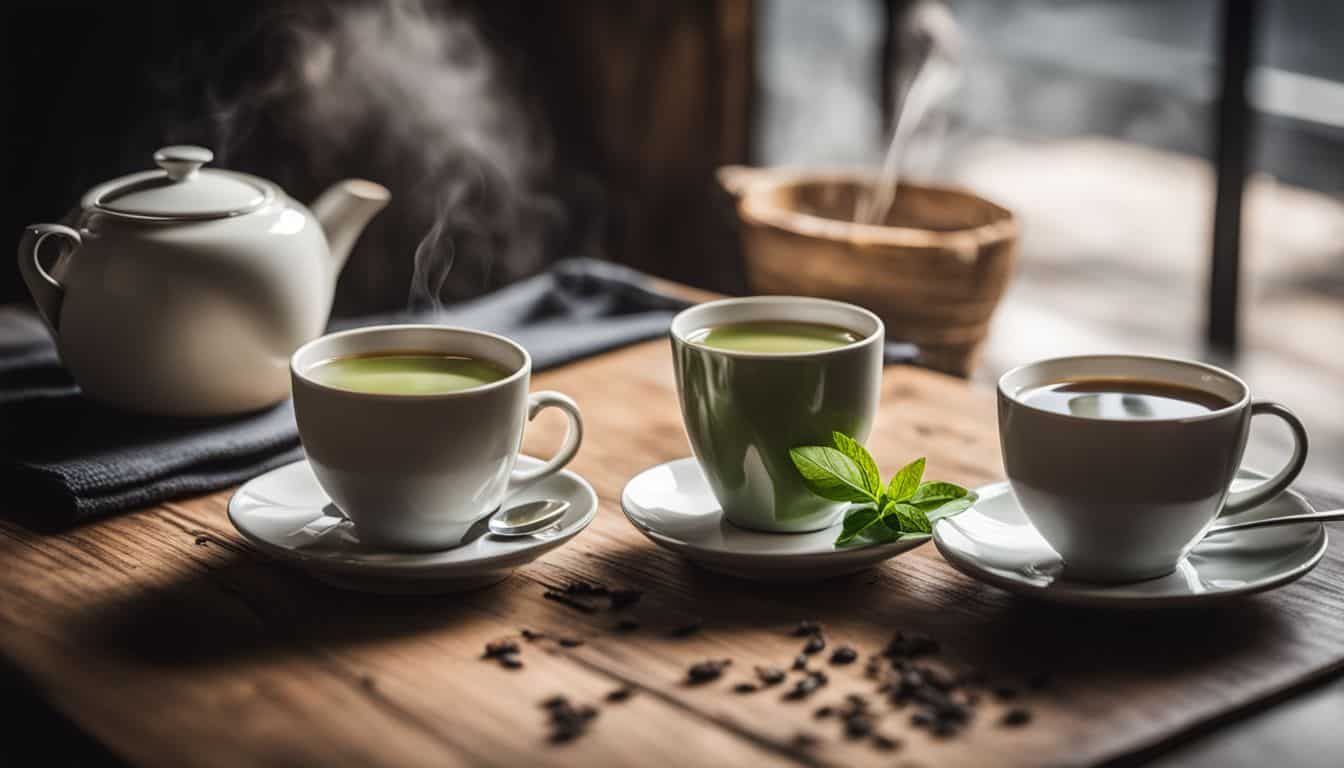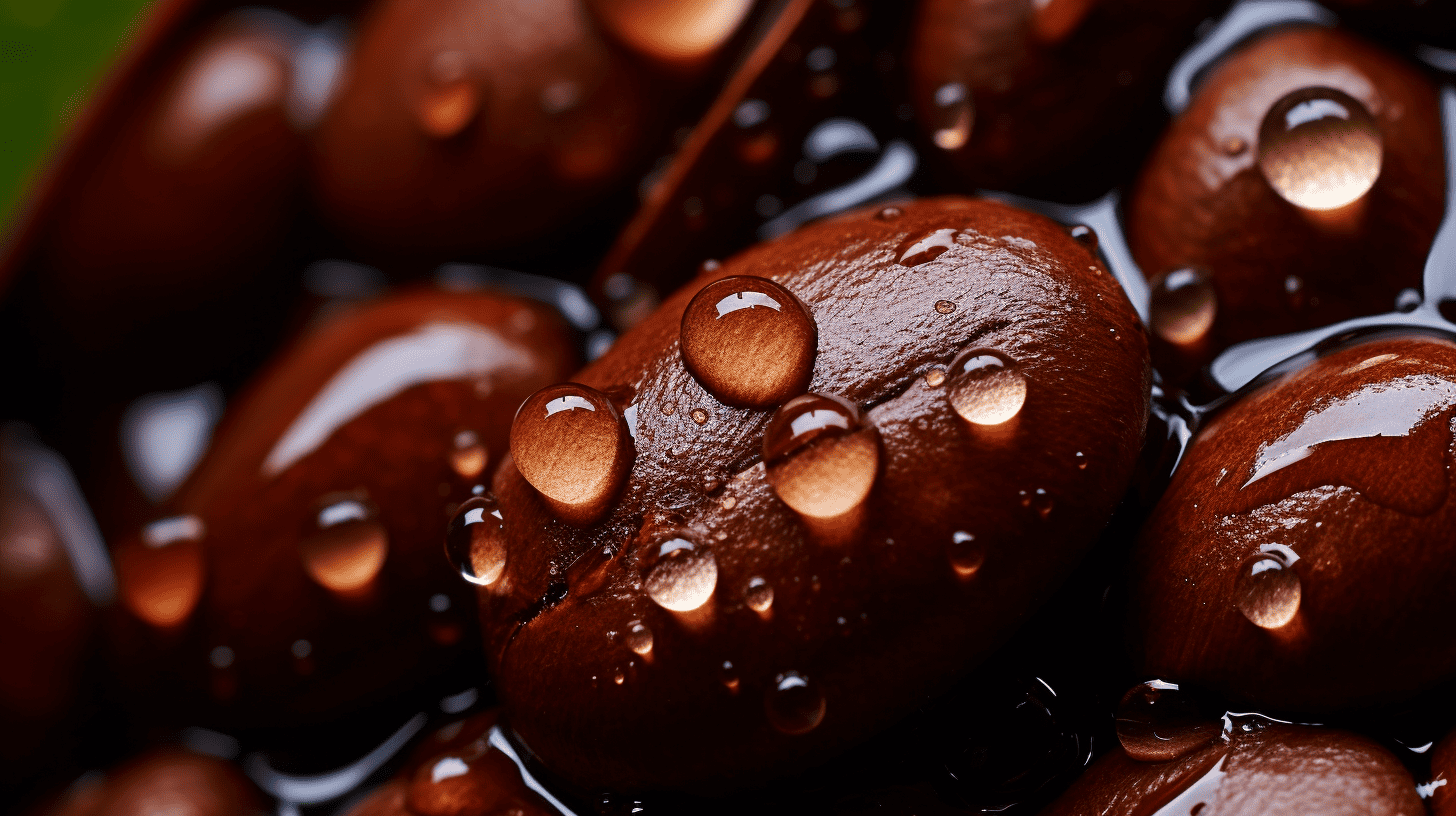Ever wondered which wakes you up more, cappuccino vs coffee caffeine? You’re not alone. After finding myself yawning mid-afternoon despite having a delightful cup of frothy cappuccino, I got curious about caffeine content in different types of coffee.
This blog will explore the fascinating comparison between the caffeine content in a cappuccino vs your everyday brew. Who knows? Your favorite morning pick-me-up might actually be falling short in delivering that much-needed energy boost!
Key Takeaways
- Cappuccinos generally have less caffeine than regular coffee, with about 64 milligrams of caffeine in a cappuccino compared to 95 to 200 milligrams in regular coffee.
- The brewing techniques for cappuccinos and coffee result in different flavors, textures, and strength levels due to variations in the amount of caffeine extracted from the coffee beans and the ratio of ingredients used.
- The type of milk used (steamed or frothed) does not affect the caffeine content; it’s the espresso shot that makes all the difference.
Caffeine Content of Cappuccino vs Coffee
The caffeine content in cappuccino and regular coffee can vary due to differences in brewing techniques and the impact of milk on caffeine extraction.
Here is a table comparing the caffeine content of cappuccino and coffee:
| Type of Coffee | Caffeine Content |
|---|---|
| Brewed Coffee (8 oz) | 95-200 mg |
| Cappuccino (8 oz) | 64-100 mg |
| Cappuccino (12 oz) | 75 mg |
| Cappuccino (16 oz) | 150 mg |
| Latte (12 oz) | 155 mg |
| Latte (16 oz) | 173 mg |
Based on the results, brewed coffee generally has more caffeine than cappuccino. However, the caffeine content of cappuccino can vary depending on the size, the number of espresso shots used, and other factors. A cappuccino typically contains one shot of espresso, which has around 68-100 mg of caffeine.
A 12 oz cappuccino has around 75 mg of caffeine, while a 16 oz cappuccino has about 150 mg of caffeine. A latte, which is similar to a cappuccino but with more milk, has more caffeine than a cappuccino, with a 12 oz latte containing around 155 mg of caffeine and a 16 oz latte containing around 173 mg of caffeine.
It is important to note that the caffeine content of coffee and cappuccino can vary depending on the type of coffee beans used, the roasting process, and other factors.
Varying degrees of caffeine
Caffeine in coffee drinks can change a lot. It depends on how you make your drink. Coffee often has more caffeine than cappuccino. A normal cup of coffee can have 77 to 150 milligrams of caffeine.
Cappuccinos also have caffeine, but less – about 64 milligrams or so for each drink. Even though they both come from the same beans, the way we brew them changes their caffeine levels.
Things like how much ground coffee and water you use can play a role too. That means sometimes, your regular cup of coffee could have as much caffeine as a cappuccino! Sizes matter as well, because bigger cups mean more caffeine most times.
Other factors that may change the amount of caffeine include what type of beans you pick and how big your serving size is. For example, espresso-based drinks like lattes and cappuccinos normally have around 173 milligrams in a big 16-ounce cup.
But don’t think all cappuccinos are high in caffeine! They use milk and foam just as much as they use espresso. So while an average cappuccino may hold about 75 milligrams, other coffees with more espresso might contain more.

Differences in brewing techniques
The brewing techniques for cappuccino and coffee differ in a few ways:
- Cappuccinos are made using an espresso machine, which forces hot water through finely ground coffee beans to create a concentrated shot of espresso. Regular coffee is brewed by pouring hot water over coarser ground coffee beans.
- Cappuccinos are made with equal parts espresso, steamed milk, and milk foam. Coffee is typically served black or with added cream and sugar.
- The preparation of cappuccinos involves frothing the milk using steam to create a creamy texture and a layer of foam on top. Coffee does not typically have frothed milk or foam.
- Cappuccinos are usually smaller in size compared to regular cups of coffee.
- The brewing time for cappuccinos is shorter since it involves pulling shots of espresso, while regular coffee requires longer steeping time.
Impact of milk on caffeine content
The amount of milk in your cappuccino can affect the caffeine content. Cappuccinos have equal parts espresso, steamed milk, and milk foam. The steamed milk and foam can dilute the coffee and reduce its caffeine concentration.
So if you prefer less caffeine, a cappuccino might be a better choice than a regular cup of coffee. But remember that the exact amount of caffeine can vary depending on how the cappuccino is made and which coffee beans are used.
Flavor and Strength Comparison
Cappuccino and coffee have different flavor profiles due to variations in brewing techniques, such as the use of steamed milk in cappuccinos and frothed milk in regular coffee.
Steamed milk vs frothed milk
As a coffee enthusiast, you might wonder about the difference between steamed milk and frothed milk in your caffeine intake. Steamed milk is usually used in lattes, while frothed milk is used in cappuccinos.
Here’s a breakdown:
| Steamed Milk | Frothed Milk | |
|---|---|---|
| Caffeine content | Does not add any additional caffeine. | Does not add any additional caffeine. |
| Usage in drinks | Typically used in lattes. | Used in cappuccinos and other similar drinks. |
| Texture | Has a velvety and thick texture. | Lighter and more airy. |
| Effect on the drink | Can make a drink taste smoother and creamier. | Can make a drink taste lighter and slightly less strong. |
So, whether you’re choosing a cappuccino or a latte, remember that the caffeine content isn’t affected by the type of milk used. It’s the espresso shot that makes all the difference. Also, cappuccinos generally have less caffeine than coffees made with espresso. And if you’re looking for a more frothy and light drink, opt for a cappuccino. If it’s a smooth and creamy drink you’re after, a latte might be your choice.
Conclusions About Cappuccino and Coffee Caffeine Content
Cappuccinos generally have less caffeine than coffees made with espresso, but the specific caffeine content can vary depending on personal preferences and the brewing method at various coffee shops.
Caffeine content in cappuccino
Cappuccinos have a moderate amount of caffeine. A typical 12-ounce cappuccino contains about 75 milligrams of caffeine. This is less than the amount found in regular coffee, but still enough to give you a boost of energy.
The exact caffeine content can vary depending on factors like the type of coffee beans and the brewing method used. It’s important to note that cappuccinos are not considered highly caffeinated drinks compared to some other options available.
Caffeine content in regular coffee
Regular coffee typically contains varying amounts of caffeine depending on factors such as the brewing method and the ratio of ground coffee to water. In a standard 8-ounce serving, coffee can contain anywhere from 77 to 150 milligrams of caffeine.
This means that regular coffee generally has more caffeine than cappuccino, which typically contains around 64 milligrams in an average-sized cup. However, it’s important to note that individual preferences and specific preparation methods at different coffee shops can affect the caffeine content in both regular coffee and cappuccinos.
Other Factors to Consider
Nutritional differences and the popularity of other coffee drinks should also be taken into account when comparing cappuccino and regular coffee.
Nutritional differences
There are some differences in the nutritional composition of cappuccinos and regular coffee. While both drinks provide energy from their caffeine content, cappuccino tends to have fewer calories and less fat compared to regular coffee. This is because cappuccinos usually contain a smaller amount of milk than lattes or other espresso-based drinks.
Additionally, cappuccinos often have a nice balance between carbohydrates, protein, and fat. The foam on top of the drink is made up of proteins from the milk, which adds a small amount of protein to your diet.
It’s important to note that the nutritional content can vary depending on how you prepare your cappuccino or coffee at home versus what you may get at a café or specialty shop. However, if you’re watching your calorie intake or trying to make healthier choices, opting for a traditional cappuccino with less sugar and whole milk might be a better option for you!
Can You Explain the Difference between an Americano and a Latte?
The key to understanding the difference between an Americano and a latte lies in the coffee-to-milk ratio. An Americano is created by diluting espresso shots with hot water, resulting in a bold, black coffee. On the other hand, a latte consists of a shot or two of espresso mixed with steamed milk, delivering a creamy and milder flavor. So, americano vs latte: understanding the difference ultimately boils down to the balance between coffee strength and milk texture.
FAQs on Cappuccino Vs Coffee Caffeine
1. Does cappuccino have more caffeine than regular coffee?
No, cappuccino generally has less caffeine than regular black coffee.
2. What is the difference between cappuccino and regular coffee in terms of caffeine content?
Cappuccino contains a smaller amount of espresso compared to a regular cup of coffee, resulting in less caffeine.
3. Can I get the same energy boost from drinking cappuccino as I would from regular coffee?
While cappuccinos may provide some energy boost due to their small amount of espresso, it is generally not as strong as what you would experience with a full cup of black coffee.
4. Are there any differences in taste between cappuccino and regular coffee?
Yes, there are distinct taste differences between the two drinks. Cappuccinos have a creamy texture and milder flavor compared to the bolder taste of black coffee.





Leave a Reply